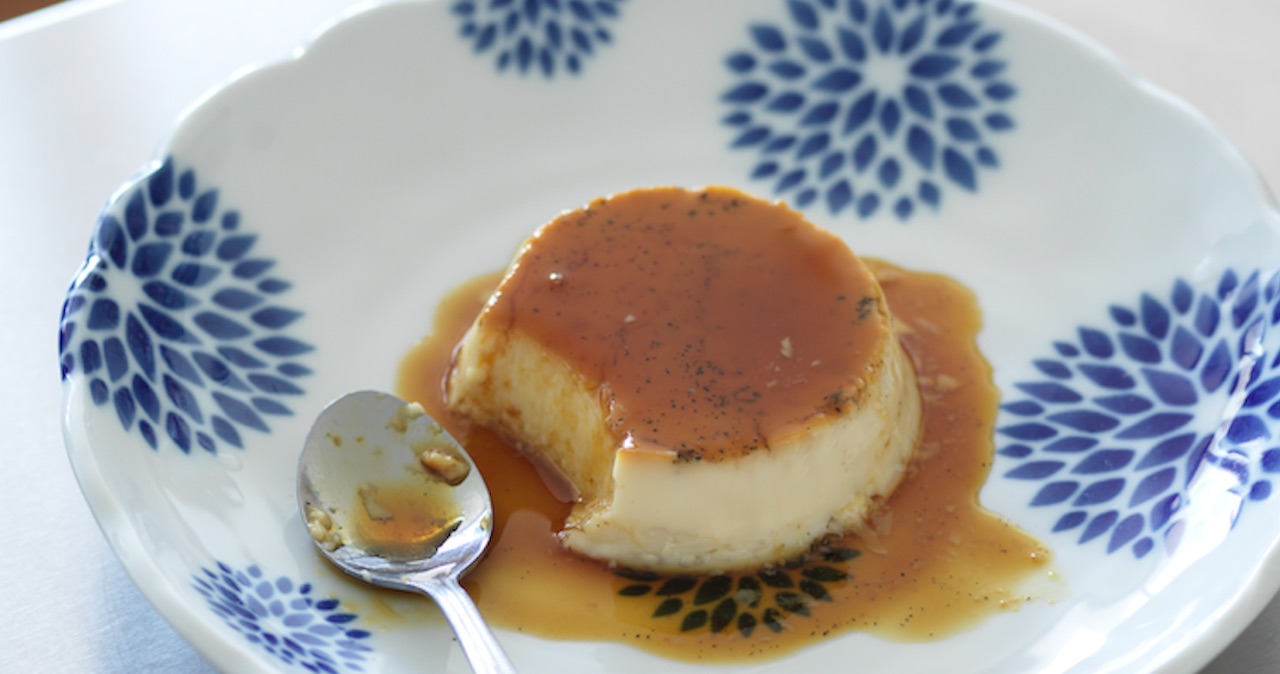
Directions
Preheat the oven to 160°C.
For the caramel, place the sugar and water in a small saucepan and allow the sugar to dissolve over a moderate heat. To help the sugar dissolve, occasionally swirl the pan in small circles - do not stir the sugar mixture. Once it starts to bubble, keep a close eye on it and wait for the liquid to turn to a deep caramel colour.
Immediately remove the caramel from the heat and pour one-third into each large ramekin. Being careful not to touch the caramel, gently swirl each ramekin in small circles to ensure that the caramel evenly coats the base and reaches the edges at the bottom.
Tap one egg on the benchtop to crack the shell, then carefully break it open over a bowl - you are trying to let the egg white flow out while keeping the yolk in one half-shell. Tip the yolk into the large mixing bowl, and repeat with 3 more eggs. Break the last two eggs (white and yolk) straight into the large bowl. Set the bowl of egg white aside for another use.
Add the sugar and whisk the eggs and sugar together until the mixture is thick and pale in colour.
If using the vanilla bean, slit it open down its length, open it up and scrape the seeds out. Place the milk and the vanilla in the other small saucepan and bring it to the boil, then pour it into the egg mixture while whisking continuously. This will ensure that the mixture will not split. Allow it to rest for a minute or so, and then skim off any foam with a ladle or large metal spoon.
Strain the custard mixture through the sieve into the large jug. Place the ramekins in the deep roasting tray. Pour some custard into each ramekin on top of the caramel, stopping before you reach the top. Carefully add cold water to the tray to come about halfway up the ramekins.
Place the tray in the oven and cook for 30 minutes, or until the custard is set. It should be slightly jiggly in the middle but fairly firm around the edges. Once set, allow to cool completely and then place in the fridge to chill for a few hours, preferably overnight. You can make it up to three days in advance.
To serve, run a thin knife carefully around the edge of each ramekin. One at a time, place a shallow serving dish on top of the ramekin and flip ramekin and dish over together. Gently shake until the custard de-moulds itself; the caramel will blanket the custard. Best served immediately.
Ingredients
Directions
Preheat the oven to 160°C.
For the caramel, place the sugar and water in a small saucepan and allow the sugar to dissolve over a moderate heat. To help the sugar dissolve, occasionally swirl the pan in small circles - do not stir the sugar mixture. Once it starts to bubble, keep a close eye on it and wait for the liquid to turn to a deep caramel colour.
Immediately remove the caramel from the heat and pour one-third into each large ramekin. Being careful not to touch the caramel, gently swirl each ramekin in small circles to ensure that the caramel evenly coats the base and reaches the edges at the bottom.
Tap one egg on the benchtop to crack the shell, then carefully break it open over a bowl - you are trying to let the egg white flow out while keeping the yolk in one half-shell. Tip the yolk into the large mixing bowl, and repeat with 3 more eggs. Break the last two eggs (white and yolk) straight into the large bowl. Set the bowl of egg white aside for another use.
Add the sugar and whisk the eggs and sugar together until the mixture is thick and pale in colour.
If using the vanilla bean, slit it open down its length, open it up and scrape the seeds out. Place the milk and the vanilla in the other small saucepan and bring it to the boil, then pour it into the egg mixture while whisking continuously. This will ensure that the mixture will not split. Allow it to rest for a minute or so, and then skim off any foam with a ladle or large metal spoon.
Strain the custard mixture through the sieve into the large jug. Place the ramekins in the deep roasting tray. Pour some custard into each ramekin on top of the caramel, stopping before you reach the top. Carefully add cold water to the tray to come about halfway up the ramekins.
Place the tray in the oven and cook for 30 minutes, or until the custard is set. It should be slightly jiggly in the middle but fairly firm around the edges. Once set, allow to cool completely and then place in the fridge to chill for a few hours, preferably overnight. You can make it up to three days in advance.
To serve, run a thin knife carefully around the edge of each ramekin. One at a time, place a shallow serving dish on top of the ramekin and flip ramekin and dish over together. Gently shake until the custard de-moulds itself; the caramel will blanket the custard. Best served immediately.